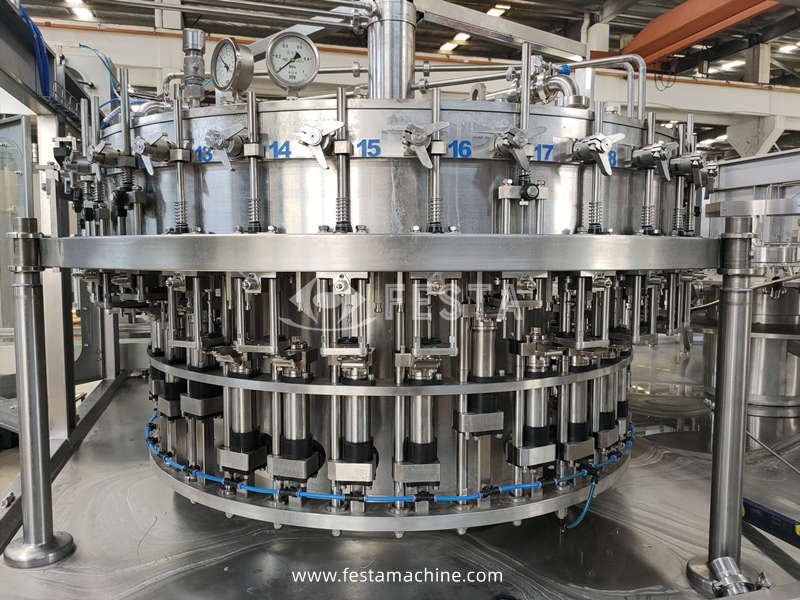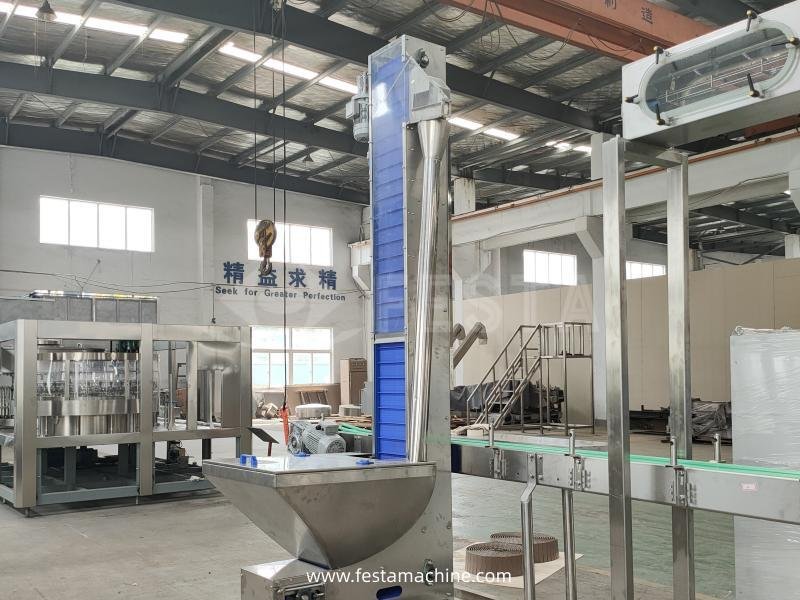ESL Filling Machine for Milk and Beverage XXGF60-60-40-15
Production Capacity: 24000 bottles per hour
Filling Temperature: 65-70℃ extended shelf life filling
Suitable Liquid: Milk filling, beverage filling
Suitable Bottle: 330ml to 2000ml PET bottles
Benefit of FESTA XXGF60-60-40-15 Extended Shelf Life Filling Machine
With a production capacity of up to 24,000 bottles per hour, the ESL filling machine reduces the filling temperature of hot filling from 83°C to 95°C to 65-70°C compared to the traditional hot filling technology. It can effectively reduce the weight of PET bottles, and there is no need to crystallize the bottle mouth, which greatly reduces the production cost of beverage companies. Also the sterilization heating temperature of beverage processing is reduced by 20℃, which effectively reduces energy consumption and positive carbon emission.
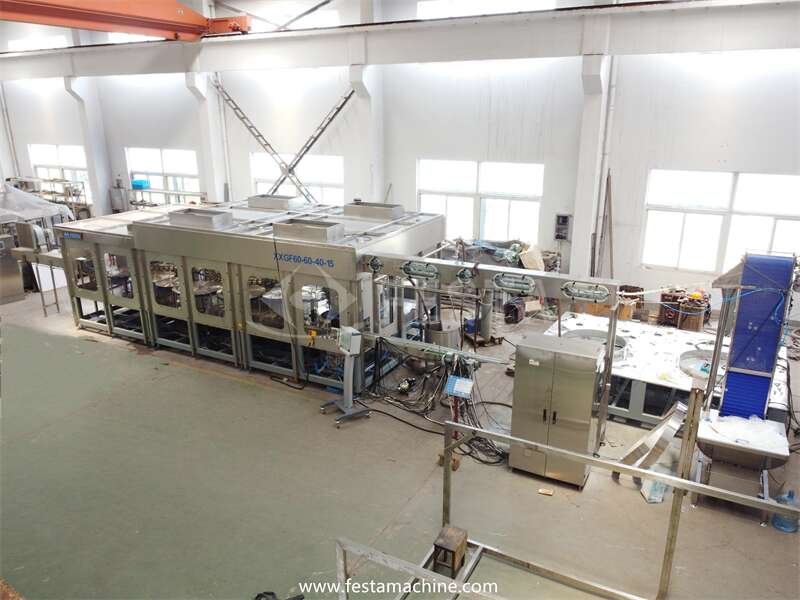
Data Sheet
Model | XXGF60-60-40-15 | |
Working station | Disinfectant rinsing heads: 60 Ozone water rinsing heads: 60 Filling heads: 40 Capping heads: 15 | |
Capacity | 24000BPH(500ml) | |
Suitable bottle | Diameter | 45~90mm |
Height | 150~300mm | |
Air pressure | 0.8MPa | |
Air consumption | 0.3 m3/min | |
Disinfectant pressure | 0.2~0.25MPa | |
Disinfectant consumption | Recycle use | |
Bottle rinsing pressure | 0.2~0.25MPa | |
Bottle rinsing consumption | 2.5t/h | |
Main motor power | 11KW | |
Dimensions | 7660X3400X3350 | |
Weight | 15000kg | |
Video
ESL(Extended Shelf Life) Filling Machine: Ultimate Guide
Application of ESL filling technology in hot filling production of PET bottles for beverages
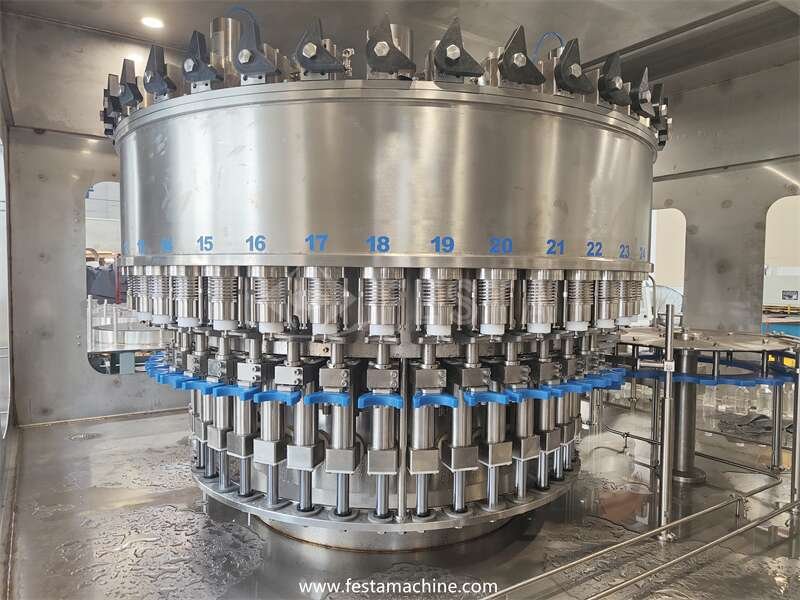
ESL (Extended shelf life) technology is a production technology that uses modern food preservation technology to reduce the bacterial content of products, reduce the chance of product spoilage and extend the shelf life of products while maximizing freshness. The technology to produce ESL products has existed in North America since 1960, when it was mainly used to produce slow-moving products such as whipped cream and coffee creamers. Now the technology has been extended to other high value-added products as well as regular beverage products. Take the current production and processing technology of ESL milk, which has received wide attention, as an example, ESL technology includes a series of strictly implemented microbial fence control techniques from dairy farm hygiene, quality control of raw milk, sterilization process, ESL filling and processing methods, processing key point control, processing equipment and finished product storage and distribution, in order to maintain the freshness of the product and improve the safety of the microbial level and extend the shelf life of the product.
Improving the sterilization conditions of the product and improving the sanitary level of the filling equipment are extremely important production aspects of ESL technology. ESL filling technology, also known as Ultra-Clean Filling, is based on the principles of microbial fencing technology and HACCP quality control theory, and uses clean filling equipment to fill sterilized materials into clean packages under a clean filling environment, thereby extending the shelf life of the product. In the production of ESL milk to be applied, but also, in recent years in the PET bottle beverage hot filling production is gradually applied, so that the application of PET bottle hot filling technology continues to expand and extend the scope.
In the PET bottle ESL hot filling technology, it is necessary to focus on the disinfection of packaging materials (bottles and caps), the purification of the filling space, the cleaning and disinfection of the outside of the filling equipment, the cleaning and disinfection of the material filling channels, and the contamination control of the personnel involved in the operation process and many other technical aspects.
Sterilization of packaging materials

In the production of PET bottles hot filling, the packaging materials in direct contact with the material are mainly PET bottles and caps. empty PET bottles are blown out when they carry a low number of colonies, but because the blown out empty bottles have their own static electricity, they are very easy to adsorb dust in the air, and dust is a good carrier of microorganisms, so the empty bottles will be contaminated by microorganisms in the storage process, and the degree of contamination is related to the PET The degree of contamination is related to the packaging method and the environment of the bottle storage [[1]]. PET bottles and caps used for ESL hot filling need to choose a reasonable packaging method and strictly control the storage and transportation conditions of the packaging materials, and at the same time, they must be disinfected before production and use. In the process design, the choice of disinfectant species, the process conditions for disinfectant use and the choice of disinfection method need to be determined according to the initial microbial contamination level of the packaging material.
In the PET bottle ESL hot filling production line, the disinfection methods for empty bottles are mainly disinfectant infusion method and spray flushing method. The disinfection methods for empty caps are mainly continuous spray flush method and immersion method. In the design of the production line, it is necessary to choose a reasonable package disinfection method according to the sterilization strength of the chosen disinfectant, the corrosiveness and irritation of the disinfectant to personnel, the operating speed and stability requirements of the production line, and the quality control level of the manufacturer.
The common disinfectants used for package disinfection in PET bottle ESL hot-fill production are hypochlorous acid, chlorine dioxide, peroxyacetic acid and compound disinfectants [[2]]. Generally speaking, in low-speed production lines, the disinfection method by infusion can generally maintain a longer disinfectant action time, so a disinfectant with a weaker germicidal capacity can be used. In medium and high speed production lines, in order to ensure the reliability of equipment operation, the disinfectant spraying method is generally used. At the same time, in order to reduce the investment cost of equipment, the process requires the disinfectant spraying, the shorter the action time, the better, so in the selection of disinfectant, the disinfectant with strong germicidal ability should be used.
In the selection of disinfectant varieties, in addition to focus on the disinfectant for microbial broad-spectrum sterilization characteristics and sterilization strength, disinfectant corrosion of equipment, disinfectant injury to the operator and disinfectant residue in the package is also a key factor to consider. For example, chlorine dioxide is a strong irritant that causes coughing, sneezing, shortness of breath, chest tightness, and irritating symptoms such as runny nose and tears after exposure, and pulmonary edema can occur at high inhalation concentrations. According to the literature, when the content of ClO2 in the air exceeds 3mg/m3 is harmful to humans, and can be detected when it reaches 14mg/m3. China stipulates that the time-weighted average permissible concentration of chlorine dioxide is 0.3 mg/m3, and the permissible concentration of short-time exposure is 0.8 mg/m3 [[3]]. In the PET bottle ESL hot filling production line, if ClO2 is selected to disinfect the package, it is inevitable that the air in the production workshop contains a certain amount of ClO2 due to the leakage of ClO2, therefore, in the design of the equipment, firstly, the equipment seal of the empty bottle disinfection area should be improved to minimize the leakage of ClO2; secondly, additional protection devices for the respiratory system of the operating workers are needed; thirdly, the Monitor the concentration of ClO2 in the air of the workshop to exclude leakage is a very necessary measure.
For the selected disinfectant process use conditions (such as temperature, concentration and time), before production use, should refer to the “Disinfection Technical Specification” – disinfectant on the surface of the object simulation site and site disinfection identification test in the method specified in the disinfection solution disinfection effect verification test to verify the process conditions on the package disinfection equipment reasonableness and reliability.
Air purification for filling spaces
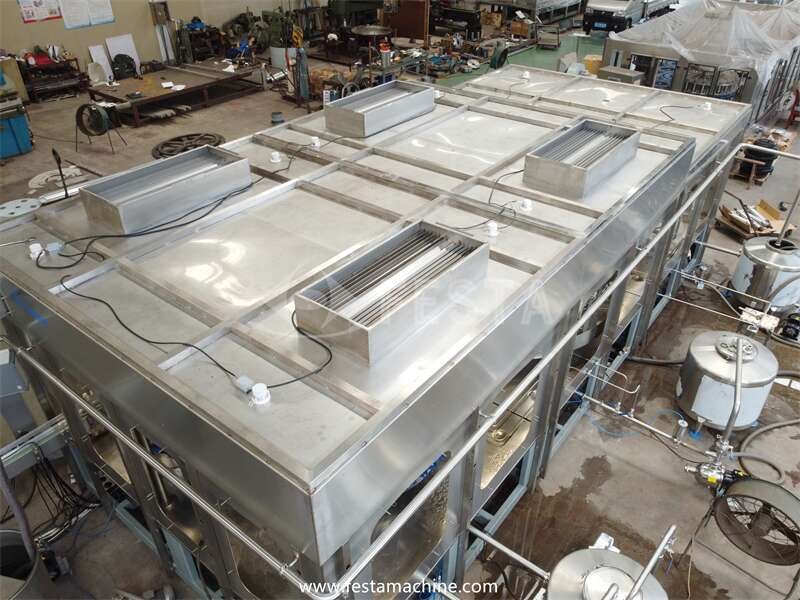
In the PET bottle ESL hot filling process, to prevent secondary contamination of filled semi-finished products by microorganisms in the air, the installation of air purification systems in the filling area of the production line is an indispensable measure.
Air purification system can be divided into industrial clean room with the control of inanimate particles as the object and biological clean room with the control of animate particles (bacteria) and lifeless particles (dust) on the working object. PET bottle ESL hot filling process requires the purification of the filling area of the production line using biological clean room, the static control level of microorganisms should reach the national standard of class 100 purification (see Table-8)
Different from the clean room which mainly controls dust, the main purpose of biological clean room is to control microorganisms. Most of the live microorganisms in the air are attached to dust particles and form bioactive particles. In the biological clean system in the PET bottle ESL hot filling production line, the first thing is to remove the microorganisms attached to the dust surface in the air by filtering the dust through HEPA high efficiency filter, but because HEPA is only a physical method of removing bacteria, bacteria are easy to accumulate on the walls, ceiling and equipment surface of the clean system, and to meet the technical requirements of the biological clean room, so in the design of the clean system The disinfection method is also needed to kill the microorganisms in the clean room. The implementation is accomplished in several synergistic ways.
(1) Periodic disinfection of the filling area during production preparation by means of drug fumigation.
(2) Cleaning and disinfection of equipment surfaces prior to production using COP and SOP operations.
(3) Ozone disinfection is used before and during production; that is, the circulating air of the HVAC system is used as the carrier of ozone, and the circulating air generated by the purifying fan in the HVAC system spreads ozone to the whole clean area under control, and makes the concentration of ozone in the air uniform, which has the effect of killing miscellaneous bacteria and molds on the HVAC system, and it is found in practice that this disinfection and sterilization method also has the effect of lysing and evacuating the high efficiency The practice found that the disinfection and sterilization method can also play the role of lysis of bacteria to the high-efficiency filter to extend its service life.
(4) The filling area is equipped with an automatic disinfection liquid aerosol spray fumigation system, which can automatically and regularly disinfect the filling space and its equipment surface.
In the PET bottle ESL hot filling air cleaning system, it is different from the common hot filling purification method, which adopts a purifying air circulation system that the filling area and operation area are independent of each other (see Figure-1 and 2), and this purification method has the following advantages.
(1) It can prevent the odor of disinfection solution from evaporating into the filling operation area and improve the working environment of operators.
(2) It can reduce the pollution of the filling area by the activities of the personnel in the filling operation area.
(3) It can significantly improve the purification level of the filling area under dynamic.
In the new PET bottle ESL hot filling machine, the PET bottle aseptic filling purification method is also adopted, using the Isolator (Isolator) method to ensure the cleanliness requirements of each work area.
Cleaning and disinfection of the exterior of the filling equipment within the filling area

In the PET bottle ESL hot filling process, the secondary contamination of the filling link caused by the multiplication of microorganisms on the surface of the equipment is a gradual process, due to incomplete cleaning of the equipment surface or the environment, or in the production process of material spilled on the surface of the equipment, will enrich some of the nutrients and lead to the survival and reproduction of some microorganisms, when the microorganisms multiply to a certain extent will form “biofilm”, under the protection of biofilm, all kinds of miscellaneous bacteria multiply rapidly. Once the conditions permit, it will destroy the degree of sanitation and purification in the filling clean zone. Therefore, in the PET bottle ESL hot filling production line, in order to ensure the cleanliness of the filling environment, it is necessary to achieve the cleaning and disinfection of the outer surface of the equipment in the purification isolation zone by the COP (Cleaning-Out-Of-Place) foam cleaning method and SOP (Sterilization -Out-Of-Place) disinfection method.
The method of COP foam cleaning is to add the foam master batch to the high pressure water in proportion, the solution is fully mixed with compressed air in the mixer to make it foam, and then the foam cleaning solution is sprayed on the surface of the object to be cleaned through the special COP device, and the cleaning solution keeps sufficient contact time with the dirt (usually l0~15 minutes), and then the dirt in a very easy to peel state can be easily removed by washing with high pressure water. Easy to remove. This method requires only a small amount of detergent to achieve a good cleaning effect. In addition, by adjusting the air mixing ratio, the softness and hardness of the foam can be adjusted so that the foam has strong adhesion on the vertical surface.
COP foam cleaning and SOP disinfection have unique advantages, which are as follows.
(1) Significant savings in manpower and chemicals used for cleaning and disinfection.
(2) can be completed in a relatively short period of time to clean a large area of cleaning work.
(3) due to the foam has a certain adhesion, so that the chemical contact with the treated surface time is relatively long.
(4) because the foam has a certain fluidity, so that the cleaning agent or disinfectant can penetrate into the very smooth crevices or grooves to prevent sanitary dead ends.
Foam cleaning device has the same fixed and mobile lightweight two, for large-scale production of factories, suitable for the use of fixed centralized control device, small-scale factories and small cleaning objects suitable for the use of mobile lightweight device.
As foam cleaning and disinfection chemicals are mainly alkaline foam agent, acid foam agent and disinfection foam agent. With automatic foam cleaning equipment, the seven-step process of “water rinsing → alkaline foam → water rinsing → acidic foam → water rinsing → disinfection foam → water rinsing” and the five-step process of “water rinsing → alkaline (acidic) foam → water rinsing disinfection foam → water rinsing” can be completed. A variety of cleaning and disinfection procedures to achieve the purpose of cleaning and disinfection of the external surface of the filling equipment in the filling area. At the same time, the cleanliness of the filling area is ensured through synergy with the air purification system in the filling space.
Cleaning and disinfection of material filling channels

The logistics filling channel between the material sterilizer and the filling machine is one of the main links of microbial secondary contamination caused by sterilized products, and maintaining the cleanliness of the logistics filling channel is one of the crucial aspects of the PET bottle ESL hot filling technology. Therefore, in the design, installation and production use process, the material filling channel needs to be given key consideration. In the design process, the use of non-sterile class valves should be avoided in the material filling channel, while the material sterilization machine and filling machine should be used between the direct connection to avoid secondary contamination caused by the unavoidable sanitary dead space that exists in the material high level tank commonly used in hot filling production lines; in the installation process of the production line, the material sterilization machine and filling machine between the material channel should be considered to be able to adequately clean and disinfection to avoid Sanitary dead ends, the use of stainless steel pipes inside and outside should be polished (sanitary pipe, internal polishing Ra ≤ 0.4μm, external polishing Ra ≤ 1.6μm), the connection between the pipes as far as possible using welding, reduce the use of card or round nut quick-fit way of connection, because every pipe to join a seal, in a sense equal to the inner wall to increase the two slits, easy to cause the retention of impurities and Microbial growth. The welding of the pipes should be inert gas shielded welding, and the welded pipes should undergo strict degreasing, pickling and passivation treatment; before production, the logistics filling channel between the material sterilizer and the filling machine must undergo strict CIP (Cleaning-In-Place) and SIP (Sterilization-In-Place) operations, for this reason, in the PET bottle ESL hot filling production line, need to be equipped with professional CIP devices for material sterilization equipment and filling machine cleaning, at the same time, according to the different forms of filling machine filling valve and the different nature of the filled products, need to use disinfectant method SIP, food-grade steam method SIP or hot water method SIP for effective sterilization operation of the logistics channel.
Contamination control of relevant personnel during operation

In the production of PET bottle ESL hot filling, the prevention of secondary contamination from operators is a very important aspect, for this reason, it is necessary to strengthen the cultivation of microbiological quality awareness of operators, at the same time, the establishment of emergency disinfection measures for accidental human contamination during maintenance operations, and the establishment of a reasonable HACCP quality control system to reduce the riskiness of production.
In recent years, ESL filling technology has been applied to some extent in the production of hot filling of PET bottles. For example, in the production of hot filling of juice drinks and running drinks PET bottles with PH ≤ 4.5, by applying ESL filling technology, the filling temperature in the hot filling process can be reduced from 83°C to 95°C to 65-70°C. On the premise of not adding preservatives, it makes the health index of drinks produced with non-heat-resistant PET bottles reach the health technical index of heat-resistant PET bottled drinks and The application of ESL filling technology in the hot filling line of lactic acid beverage PET bottles can make the product meet the standard requirements at room temperature.


